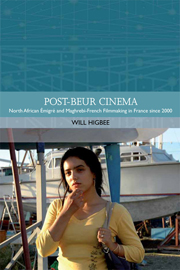Book contents
- Frontmatter
- Contents
- Acknowledgements
- List of Illustrations
- Traditions in World Cinema
- 1 Introduction: From Immigrant Cinema to National Cinema
- 2 The (Maghrebi-)French Connection: Diaspora goes Mainstream
- 3 Colonial Fracture and the Counter-Heritage Film
- 4 Of Spaces and Difference in the Films of Abdellatif Kechiche
- 5 Home, Displacement and the Myth of Return: Journey Narratives in the 2000s
- 6 Screening Islam: cinematic Representations of the Muslim Community in France in the 2000s
- 7 Conclusion: Post-Beur Cinema
- Bibliography
- Index
6 - Screening Islam: cinematic Representations of the Muslim Community in France in the 2000s
Published online by Cambridge University Press: 05 October 2013
- Frontmatter
- Contents
- Acknowledgements
- List of Illustrations
- Traditions in World Cinema
- 1 Introduction: From Immigrant Cinema to National Cinema
- 2 The (Maghrebi-)French Connection: Diaspora goes Mainstream
- 3 Colonial Fracture and the Counter-Heritage Film
- 4 Of Spaces and Difference in the Films of Abdellatif Kechiche
- 5 Home, Displacement and the Myth of Return: Journey Narratives in the 2000s
- 6 Screening Islam: cinematic Representations of the Muslim Community in France in the 2000s
- 7 Conclusion: Post-Beur Cinema
- Bibliography
- Index
Summary
Given the extent to which the integration of France's North African Muslim population has been foregrounded in public debates over immigration, integration and national identity since the late 1980s, it is perhaps surprising that representations of Islam have remained marginal in Maghrebi-French and North African émigré filmmaking. This is even more so the case when it is considered that films by directors of North African origin have tended to foreground narratives addressing contemporary socio-political realities concerning the Maghrebi immigrant community and their French descendants. In other ways, however, this structuring absence of Islam since the 1980s finds a clear precedence in French cinema from as far back as the colonial period, in which Islam was reduced to a series of signs associated with the picturesque and exoticism (Cadé 2011: 43). This lack of cinematic visibility given to the rites and rituals of Islam can also be viewed as evidence of the more widespread reluctance of mainstream majority French filmmakers to engage with such a potentially divisive political issue as French Islam. Finally, it speaks to how the influence of laïcité extends into the cultural sphere more generally. Whilst the stylistic and thematic concerns of certain directors may well be discussed critically in relation to their own religious upbringing, background or faith (the influence of Bresson's Catholicism on his earlier films, for example [Reader 2000: 5–7]), the representation of religion of any type has never been a significant thematic concern, aesthetic influence or narrative focus in French cinema (Boitel and Hennebelle 1988; Hennebelle 1996; Cadé 2011).
- Type
- Chapter
- Information
- Post-beur CinemaNorth African Émigré and Maghrebi-French Filmmaking in France since 2000, pp. 154 - 181Publisher: Edinburgh University PressPrint publication year: 2013



